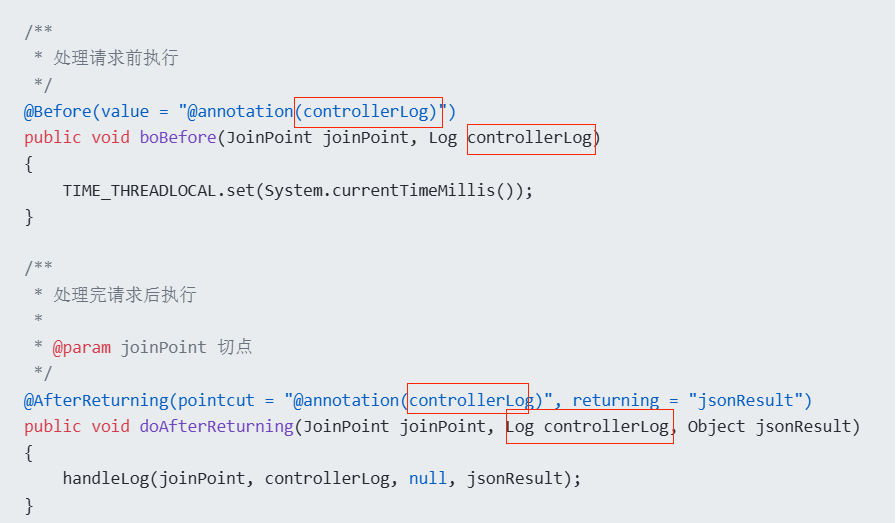java - 请问若依的这段日志aop代码是什么意思啊?
请问若依的这段日志aop代码是什么意思啊
问题代码
@Before(value = "@annotation(controllerLog)")
public void boBefore(JoinPoint joinPoint, Log controllerLog)
{
TIME_THREADLOCAL.set(System.currentTimeMillis());
}首先@annotation里不是要全限定类名的注解吗
其次controllerLog又是哪来的,项目中都找不到这个注解啊,而且业务方法上是加的@Log啊,为什么不是@annotation("com.xxx.Log")
最后,idea是怎么分辨出controllerLog是Log类的
以下是完整代码
package com.ruoyi.framework.aspectj;
import java.util.Collection;
import java.util.Map;
import javax.servlet.http.HttpServletRequest;
import javax.servlet.http.HttpServletResponse;
import org.apache.commons.lang3.ArrayUtils;
import org.aspectj.lang.JoinPoint;
import org.aspectj.lang.annotation.AfterReturning;
import org.aspectj.lang.annotation.AfterThrowing;
import org.aspectj.lang.annotation.Aspect;
import org.aspectj.lang.annotation.Before;
import org.slf4j.Logger;
import org.slf4j.LoggerFactory;
import org.springframework.core.NamedThreadLocal;
import org.springframework.stereotype.Component;
import org.springframework.validation.BindingResult;
import org.springframework.web.multipart.MultipartFile;
import com.alibaba.fastjson2.JSON;
import com.ruoyi.common.annotation.Log;
import com.ruoyi.common.core.domain.entity.SysUser;
import com.ruoyi.common.core.domain.model.LoginUser;
import com.ruoyi.common.enums.BusinessStatus;
import com.ruoyi.common.enums.HttpMethod;
import com.ruoyi.common.filter.PropertyPreExcludeFilter;
import com.ruoyi.common.utils.SecurityUtils;
import com.ruoyi.common.utils.ServletUtils;
import com.ruoyi.common.utils.StringUtils;
import com.ruoyi.common.utils.ip.IpUtils;
import com.ruoyi.framework.manager.AsyncManager;
import com.ruoyi.framework.manager.factory.AsyncFactory;
import com.ruoyi.system.domain.SysOperLog;
/**
* 操作日志记录处理
*
* @author ruoyi
*/
@Aspect
@Component
public class LogAspect
{
private static final Logger log = LoggerFactory.getLogger(LogAspect.class);
/** 排除敏感属性字段 */
public static final String[] EXCLUDE_PROPERTIES = { "password", "oldPassword", "newPassword", "confirmPassword" };
/** 计算操作消耗时间 */
private static final ThreadLocal<Long> TIME_THREADLOCAL = new NamedThreadLocal<Long>("Cost Time");
/**
* 处理请求前执行
*/
@Before(value = "@annotation(controllerLog)")
public void boBefore(JoinPoint joinPoint, Log controllerLog)
{
TIME_THREADLOCAL.set(System.currentTimeMillis());
}
/**
* 处理完请求后执行
*
* @param joinPoint 切点
*/
@AfterReturning(pointcut = "@annotation(controllerLog)", returning = "jsonResult")
public void doAfterReturning(JoinPoint joinPoint, Log controllerLog, Object jsonResult)
{
handleLog(joinPoint, controllerLog, null, jsonResult);
}
/**
* 拦截异常操作
*
* @param joinPoint 切点
* @param e 异常
*/
@AfterThrowing(value = "@annotation(controllerLog)", throwing = "e")
public void doAfterThrowing(JoinPoint joinPoint, Log controllerLog, Exception e)
{
handleLog(joinPoint, controllerLog, e, null);
}
protected void handleLog(final JoinPoint joinPoint, Log controllerLog, final Exception e, Object jsonResult)
{
try
{
// 获取当前的用户
LoginUser loginUser = SecurityUtils.getLoginUser();
// *========数据库日志=========*//
SysOperLog operLog = new SysOperLog();
operLog.setStatus(BusinessStatus.SUCCESS.ordinal());
// 请求的地址
String ip = IpUtils.getIpAddr();
operLog.setOperIp(ip);
operLog.setOperUrl(StringUtils.substring(ServletUtils.getRequest().getRequestURI(), 0, 255));
if (loginUser != null)
{
operLog.setOperName(loginUser.getUsername());
SysUser currentUser = loginUser.getUser();
if (StringUtils.isNotNull(currentUser) && StringUtils.isNotNull(currentUser.getDept()))
{
operLog.setDeptName(currentUser.getDept().getDeptName());
}
}
if (e != null)
{
operLog.setStatus(BusinessStatus.FAIL.ordinal());
operLog.setErrorMsg(StringUtils.substring(e.getMessage(), 0, 2000));
}
// 设置方法名称
String className = joinPoint.getTarget().getClass().getName();
String methodName = joinPoint.getSignature().getName();
operLog.setMethod(className + "." + methodName + "()");
// 设置请求方式
operLog.setRequestMethod(ServletUtils.getRequest().getMethod());
// 处理设置注解上的参数
getControllerMethodDescription(joinPoint, controllerLog, operLog, jsonResult);
// 设置消耗时间
operLog.setCostTime(System.currentTimeMillis() - TIME_THREADLOCAL.get());
// 保存数据库
AsyncManager.me().execute(AsyncFactory.recordOper(operLog));
}
catch (Exception exp)
{
// 记录本地异常日志
log.error("异常信息:{}", exp.getMessage());
exp.printStackTrace();
}
finally
{
TIME_THREADLOCAL.remove();
}
}
/**
* 获取注解中对方法的描述信息 用于Controller层注解
*
* @param log 日志
* @param operLog 操作日志
* @throws Exception
*/
public void getControllerMethodDescription(JoinPoint joinPoint, Log log, SysOperLog operLog, Object jsonResult) throws Exception
{
// 设置action动作
operLog.setBusinessType(log.businessType().ordinal());
// 设置标题
operLog.setTitle(log.title());
// 设置操作人类别
operLog.setOperatorType(log.operatorType().ordinal());
// 是否需要保存request,参数和值
if (log.isSaveRequestData())
{
// 获取参数的信息,传入到数据库中。
setRequestValue(joinPoint, operLog, log.excludeParamNames());
}
// 是否需要保存response,参数和值
if (log.isSaveResponseData() && StringUtils.isNotNull(jsonResult))
{
operLog.setJsonResult(StringUtils.substring(JSON.toJSONString(jsonResult), 0, 2000));
}
}
/**
* 获取请求的参数,放到log中
*
* @param operLog 操作日志
* @throws Exception 异常
*/
private void setRequestValue(JoinPoint joinPoint, SysOperLog operLog, String[] excludeParamNames) throws Exception
{
Map<?, ?> paramsMap = ServletUtils.getParamMap(ServletUtils.getRequest());
String requestMethod = operLog.getRequestMethod();
if (StringUtils.isEmpty(paramsMap)
&& (HttpMethod.PUT.name().equals(requestMethod) || HttpMethod.POST.name().equals(requestMethod)))
{
String params = argsArrayToString(joinPoint.getArgs(), excludeParamNames);
operLog.setOperParam(StringUtils.substring(params, 0, 2000));
}
else
{
operLog.setOperParam(StringUtils.substring(JSON.toJSONString(paramsMap, excludePropertyPreFilter(excludeParamNames)), 0, 2000));
}
}
/**
* 参数拼装
*/
private String argsArrayToString(Object[] paramsArray, String[] excludeParamNames)
{
String params = "";
if (paramsArray != null && paramsArray.length > 0)
{
for (Object o : paramsArray)
{
if (StringUtils.isNotNull(o) && !isFilterObject(o))
{
try
{
String jsonObj = JSON.toJSONString(o, excludePropertyPreFilter(excludeParamNames));
params += jsonObj.toString() + " ";
}
catch (Exception e)
{
}
}
}
}
return params.trim();
}
/**
* 忽略敏感属性
*/
public PropertyPreExcludeFilter excludePropertyPreFilter(String[] excludeParamNames)
{
return new PropertyPreExcludeFilter().addExcludes(ArrayUtils.addAll(EXCLUDE_PROPERTIES, excludeParamNames));
}
/**
* 判断是否需要过滤的对象。
*
* @param o 对象信息。
* @return 如果是需要过滤的对象,则返回true;否则返回false。
*/
@SuppressWarnings("rawtypes")
public boolean isFilterObject(final Object o)
{
Class<?> clazz = o.getClass();
if (clazz.isArray())
{
return clazz.getComponentType().isAssignableFrom(MultipartFile.class);
}
else if (Collection.class.isAssignableFrom(clazz))
{
Collection collection = (Collection) o;
for (Object value : collection)
{
return value instanceof MultipartFile;
}
}
else if (Map.class.isAssignableFrom(clazz))
{
Map map = (Map) o;
for (Object value : map.entrySet())
{
Map.Entry entry = (Map.Entry) value;
return entry.getValue() instanceof MultipartFile;
}
}
return o instanceof MultipartFile || o instanceof HttpServletRequest || o instanceof HttpServletResponse
|| o instanceof BindingResult;
}
}
共有2个答案

框架和IDEA都是根据读取的是方法参数上的类型信息
@Before(value = "@annotation(controllerLog)")
public void boBefore(JoinPoint joinPoint, Log controllerLog)
{
TIME_THREADLOCAL.set(System.currentTimeMillis());
}这段代码的意思是在对被注解标记的方法执行之前,将当前的时间记录下来,这样做是为了在被注解标记的方法执行之后通过计算两者之间的时间差就可以得出切入点(被增强方法)的执行时间,若依框架就是通过这样来简化获得方法的执行时间并存入数据库日志的,这段代码往下看就有@doAfterReturning(处理完请求后执行)和@doAfterThrowing(拦截异常操作),都是执行handleLog方法,注意看这里:
// 设置消耗时间
operLog.setCostTime(System.currentTimeMillis() - TIME_THREADLOCAL.get());
// 保存数据库
AsyncManager.me().execute(AsyncFactory.recordOper(operLog));就是这段逻辑。注意这里若依用了ThreadLocal线程本地类来保证线程安全,每个线程都会持有一份只属于它自己的变量拷贝。
@annotation里不是要全限定类名的注解?其次controllerLog又是哪来的,项目中都找不到这个注解啊,而且业务方法上是加的@Log啊,为什么不是@annotation("com.xxx.Log")?最后,idea是怎么分辨出controllerLog是Log类的
可以是全限定类名的注解,但在这里用的其实就是形参Log controllerLog代表的全限定类名的注解的意思,对应的全限定类名就是 com.ruoyi.common.annotation.Log,这种写法就方便你可以直接把指定类写在方法入参里使用IDLE来帮助你补全引入。最后IDEA是根据aspectj的源代码里对于切面表达式的解析规则来分辨的。
-
b & 0xFF for b in这个怎么理解
-
当我使用spark运行一个作业时,我会得到以下日志?
-
问题内容: 我是Go的新手,在浏览其他一些线程时遇到了以下代码行: 含义是什么?它是否指定将在if条件中分配某些内容(因为err似乎正在发生这种情况)?我在Wiki上找不到这种语法的示例,并且我很好奇它的用途。 问题答案: 因为返回两个值,所以如果需要它们中的任何一个,都必须在某个地方接收这些值。该是一个占位符,基本的意思是“我不关心这个特殊的返回值。” 在这里,我们只关心检查错误,而无需对实际的
-
所以我有这行代码。它给了我输出[6,28]。你们知道为什么吗?我不知道有人想打印什么样的数字。
-
在这段代码中,两个连接和断开是什么意思?导致停止,直到终止?
-
问题内容: 问题答案: 作用 在你的Chrome浏览器的控制台中输入这段代码,你会发现不同HTML层都被使用不同的颜色添加了一个高亮的边框。是不是非常酷?但是,简单来说,这段代码只是首先获取了所有的页面元素,然后使用一个不同的颜色为它们添加了一个1px的边框。 解析 => 调用引用数组的forEach方法 => => => 对二进数1小数点右移24位 => 获得了一个位于之间的随机整数,也就是随机

